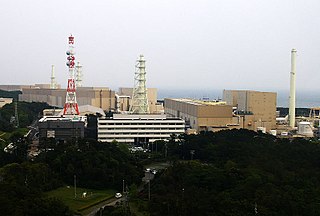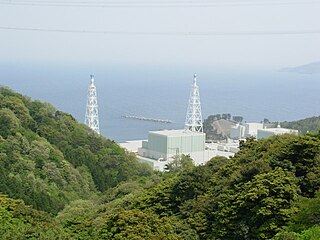 W
WAinu Revolution Theory is a left-wing political idea in Japan that was active in the 1970s. It was a variant of Proletarian Revolution Theory that came to light shortly after the revision of the Treaty of Mutual Cooperation and Security Between the United States and Japan, focusing on the Ainu. The actions and writings of Japanese left-wing thinker Ota Ryu in particular made Ainu Revolution Theory well known.
 W
WFugen ふげん was a prototype Japanese nuclear test reactor. Fugen was a domestic Japanese design for a demonstration Advanced Thermal Reactor. It was a heavy water moderated, boiling light water cooled reactor. The reactor was started in 1979 and shut down in 2003. As of 2018, it is undergoing decommissioning. It is located in Myōjin-chō, in the city of Tsuruga, Fukui. The name "Fugen" is derived from Fugen Bosatsu (Samantabhadra), a Buddhist deity.
 W
WThe Fukushima Daini Nuclear Power Plant is a nuclear power plant located on a 150 ha (370-acre) site in the town of Naraha and Tomioka in the Futaba District of Fukushima Prefecture, Japan. The Tokyo Electric Power Company (TEPCO) runs the plant.
 W
WThe Genkai Nuclear Power Plant is located in the town of Genkai in the Higashimatsuura District in the Saga Prefecture in Japan. It is owned and operated by the Kyūshū Electric Power Company.
 W
WThe Hamaoka Nuclear Power Plant is a nuclear power plant in the city of Omaezaki in Shizuoka Prefecture, on Japan's east coast, 200 km south-west of Tokyo. It is managed by the Chubu Electric Power Company. There are five units contained at a single site with a net area of 1.6 km2. A sixth unit began construction on December 22, 2008. On January 30, 2009, Hamaoka-1 and Hamaoka-2 were permanently shut down.
 W
WThe Ikata Nuclear Power Plant is a nuclear power plant in the town of Ikata in the Nishiuwa District of Ehime Prefecture, Japan. It is the only nuclear plant on the island of Shikoku. It is owned and operated by the Shikoku Electric Power Company. The plant was shut down along with all other nuclear plants in Japan following the Fukushima Daiichi nuclear disaster. Unit 3 was reactivated using plutonium-uranium mixed oxide fuel on 12 August 2016 and began providing electricity to the grid three days later. On 13 December 2017, the Hiroshima High Court issued a temporary injunction to halt the operation of the Ikata 3 nuclear reactor until September 2018.
 W
WKaraoke is a type of interactive entertainment usually offered in clubs and bars, where people sing along to recorded music using a microphone. The music is an instrumental version of a well-known popular song. Lyrics are usually displayed on a video screen, along with a moving symbol, changing colour, or music video images, to guide the singer. In Chinese-speaking countries and regions such as mainland China, Hong Kong, Taiwan and Singapore, a karaoke box is called a KTV. The global karaoke market has been estimated to be worth nearly $10 billion.
 W
WThe Ōi Nuclear Power Plant , also known as Oi or Ohi, is a nuclear power plant located in the town of Ōi, Fukui Prefecture, managed by the Kansai Electric Power Company. The site is 1.88 square kilometers. Ōi Units 3 and 4 were taken offline in September 2013. In December 2017 Kansai Electric Power announced that it will decommission reactors no. 1 and 2 because of their age and the difficulty of making safety upgrades within their small containment vessels. Unit 3 was restarted on 14 March 2018, and unit 4 was restarted on 9 May 2018.
 W
WThe Sendai Nuclear Power Plant is a nuclear power plant located in the city of Satsumasendai in Kagoshima Prefecture. The two 846 MW net reactors are owned and operated by the Kyūshū Electric Power Company. The plant, like all other nuclear power plants in Japan, did not generate electricity after the nationwide shutdown in the wake of the Fukushima Daiichi nuclear disaster in 2011, but was restarted on August 11, 2015, and began providing power to nearby towns again. Sendai is the first of Japan's nuclear power plants to be restarted.
 W
WThe Shimane Nuclear Power Plant is a nuclear power plant located in the town of Kashima-chou in the city of Matsue in the Shimane Prefecture. It is owned and operated by the Chūgoku Electric Power Company.
 W
WThe Takahama Nuclear Power Plant is a nuclear power plant located in the town of Takahama, Ōi District, Fukui Prefecture. It is owned and operated by the Kansai Electric Power Company. It is on a site with an area of about 1 km2. The four pressurized water reactors give the plant a total gross electric capacity of 3,392 MW and average yearly production of 22,638 GW·h.
 W
WThe Year 24 Group is a grouping of female manga artists who heavily influenced shōjo manga beginning in the 1970s. While shōjo manga of the 1950s and 1960s largely consisted of simple stories marketed towards elementary school-aged girls, works by members of the group significantly developed shōjo manga by expanding it to incorporate new genres, themes, and subject material. Narratives and art styles in shōjo manga became more complex, and works came to examine topics such as psychology, gender, politics, and sexuality. Manga produced by the Year 24 Group brought the shōjo category into what scholars have described as its "golden age".